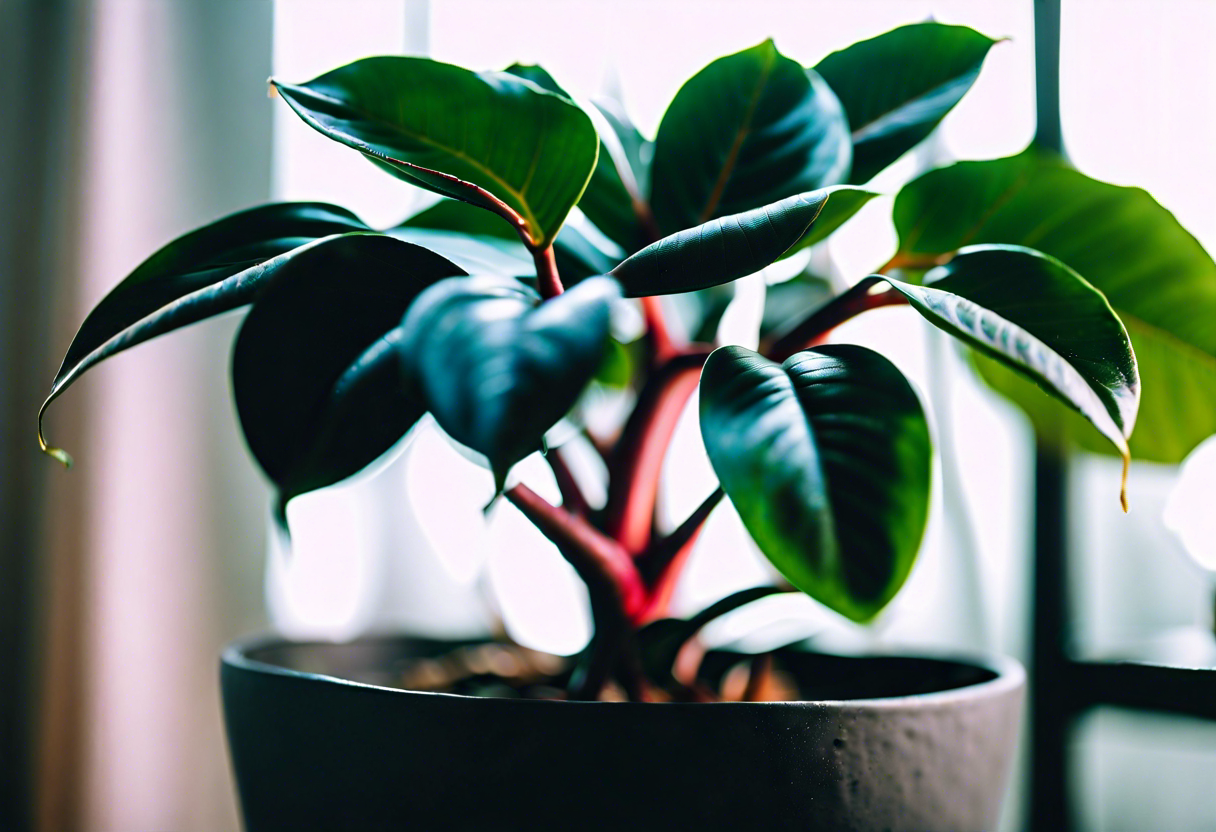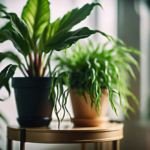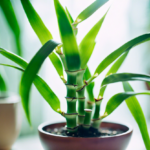The Ideal Conditions for Growing a Rubber Plant
Ficus elastica, commonly known as the Rubber Plant, is a popular choice among indoor plant enthusiasts due to its attractive glossy leaves and easy care requirements. To ensure successful growth and optimum health for your Rubber Plant, it’s important to provide it with the right conditions.
Temperature: Rubber Plants thrive in warm temperatures ranging from 60°F to 85°F (15°C to 30°C). Avoid exposing them to temperatures below 50°F (10°C), as this can cause damage to the plant.
Light: While these plants can tolerate various light conditions, they prefer bright, indirect light. Place your Rubber Plant near a north or east-facing window where it can receive filtered sunlight. However, avoid exposing it to direct sunlight for prolonged periods, as this can scorch the leaves.
Humidity: Rubber Plants prefer moderate to high humidity levels. If the air in your home is dry, you can increase humidity by misting the leaves regularly or placing a humidifier nearby. This will help prevent the leaves from drying out and becoming brown around the edges.
Soil: Well-draining soil is essential for Rubber Plant care. A mix of potting soil, perlite, and peat moss creates a suitable medium that allows excess water to drain away from the roots, preventing rot.
Watering: When it comes to watering, it’s important to strike a balance. Over-watering can lead to root rot, while under-watering can cause the leaves to wilt and drop off. Allow the top inch of soil to dry out between waterings, and then thoroughly soak the soil until water drains out of the bottom of the pot.
Fertilizer: Regular feeding with a balanced, water-soluble fertilizer is essential for the health of your Rubber Plant. During the growing season (spring and summer), feed it every two weeks. In the dormant period, reduce fertilization to once a month.
Pruning: Rubber Plants can grow quite large, so occasional pruning helps maintain their shape and size. Remove any yellowing or dead leaves, and trim back leggy growth to encourage bushier growth.
Propagation: If you’d like to expand your Rubber Plant collection, you can propagate them through stem cuttings. Take a 6-inch cutting from a healthy plant, remove the lower leaves, and place it in moist soil or water until roots develop.
By providing the ideal conditions of temperature, light, humidity, soil, watering, and proper care, you can enjoy the beauty and benefits of a thriving Rubber Plant in your indoor space.
Watering and Humidity Needs of a Rubber Plant
Proper care and attention to watering and humidity are essential to ensure the healthy growth of a Rubber Plant (Ficus elastica). Providing the right amount of water and maintaining appropriate humidity levels will help the plant thrive and prevent common issues such as root rot or leaf drop. Here are some guidelines to follow:
Watering: The watering needs of a Rubber Plant vary depending on factors such as environmental conditions, pot size, and plant size. It is crucial to avoid overwatering, as this can lead to root rot. Allow the top inch or two of soil to dry out between waterings. Before watering, you can check the moisture level by sticking your finger into the soil. If it feels dry, it’s time to water the plant. Ensure that the water drains freely from the pot to prevent waterlogging.
Humidity: Rubber Plants are native to tropical regions, where they thrive in high humidity. While they can adapt to lower humidity levels, providing adequate humidity will encourage optimal growth. You can increase humidity by misting the plant’s leaves regularly or by placing a tray of water near the plant. Another effective method is to use a humidifier, especially during dry seasons or in indoor environments with low humidity.
Temperature: Rubber Plants prefer temperatures between 60-85°F (15-29°C). They can tolerate slightly cooler temperatures but are sensitive to cold drafts. Avoid placing your Rubber Plant near doors or windows where it may be exposed to chilly drafts, as this can lead to leaf damage or dropping.
Soil: The right soil mix is essential for Rubber Plant care. A well-draining potting mix that retains some moisture while allowing excess water to drain out is ideal. You can mix regular potting soil with perlite or orchid bark to improve drainage. Avoid using heavy clay-based soils that retain excess moisture, as this can lead to root rot.
Container size: When selecting a pot for your Rubber Plant, choose one that allows for adequate drainage and gives the roots room to grow. Avoid placing the plant in a pot that is too large, as excess soil can retain moisture and lead to waterlogged roots.
Seasonal adjustments: During the growing season, which is typically spring and summer, the Rubber Plant may require more frequent watering as it actively grows. In winter, reduce the watering frequency as growth slows down. Monitor the soil moisture level and adjust your watering schedule accordingly.
By paying close attention to watering and humidity, you can create a favorable environment for your Rubber Plant. Remember, each plant is unique, so it’s essential to observe and adjust your care routine based on the specific needs of your Rubber Plant. With proper care, your Rubber Plant will thrive and add beauty to your indoor or outdoor space.
Light Requirements for Rubber Plants: Finding the Perfect Spot
Rubber plants (Ficus elastica) are popular indoor plants known for their large, glossy leaves and ability to thrive in various light conditions. When it comes to providing the ideal light for your rubber plant, finding the perfect spot is crucial. In this guide, we will explore the light requirements of rubber plants and offer tips on creating the optimal environment for their growth.
Understanding Light Requirements
Rubber plants are typically categorized as medium to high light plants. This means they require bright, indirect light to thrive. Direct sunlight, especially during the peak hours of the day, can scorch their leaves and cause damage. On the other hand, insufficient light can result in stunted growth and leaf drop.
Indoor Placement
When it comes to indoor placement, finding a spot near a window that offers bright, indirect light is ideal for your rubber plant. East or west-facing windows are generally recommended, as they provide sufficient light without exposing the plant to intense, direct sunlight. Placing the plant a few feet away from the window can help reduce the intensity of light and prevent leaf burn.
If your home does not have access to adequate natural light, you can also grow a rubber plant under artificial lighting. In this case, using fluorescent lights or LED grow lights can provide the necessary light spectrum for healthy growth. Keep in mind that the light source should be situated close to the plant to ensure it receives an adequate amount of light.
Consideration for Light Intensity
While rubber plants require bright light, it’s important to strike a balance and avoid exposing them to intense, direct sunlight. To determine if your rubber plant is receiving the right amount of light, observe its leaves. If they appear pale or yellowish, it may indicate that the plant is not receiving enough light. Conversely, if the leaves start to develop brown or black spots, it may be a sign of excessive light exposure.
Rotation and Adjustments
To ensure even growth and prevent the plant from leaning towards the light source, it’s beneficial to rotate your rubber plant periodically. This allows all sides of the plant to receive an equal amount of light, promoting symmetrical growth. Additionally, if you notice that specific parts of the plant are receiving more light than others, you can adjust the placement accordingly.
Providing the right amount of light is essential for the health and growth of your rubber plant. Remember to place your plant in a spot that offers bright, indirect light, and avoid exposing it to intense, direct sunlight. Regularly assess the light intensity and make necessary adjustments to ensure optimal growth. With proper light care, your rubber plant will thrive and beautify your indoor space for years to come.
Proper Feeding and Fertilizing for Optimum Rubber Plant Growth
A well-nourished rubber plant (Ficus elastica) is not only visually appealing but also healthier and more resistant to pests and diseases. In order to provide the necessary nutrients for your rubber plant’s growth, it’s crucial to follow the proper feeding and fertilizing techniques.
Firstly, it’s important to start fertilizing your rubber plant during the active growing season, which typically occurs in spring and summer. Avoid fertilizing during the dormant period in winter, as the plant’s growth slows down significantly during this time.
When choosing a fertilizer for your rubber plant, opt for a balanced, water-soluble product. Look for a fertilizer with an NPK ratio (nitrogen, phosphorus, and potassium) of around 10-10-10 or 20-20-20. If you prefer an organic option, you can use a diluted liquid seaweed solution instead.
Before applying the fertilizer, ensure that the soil is moist. This helps prevent root burn and allows for better absorption of nutrients. Take care not to overfeed the rubber plant, as excessive fertilizer may cause nutrient toxicity and damage the roots.
During the active growing season, fertilize your rubber plant once every two weeks. Dilute the fertilizer according to the manufacturer’s instructions and apply it to the soil around the base of the plant. Avoid direct contact with the leaves, as this can result in fertilizer burn.
Aside from regular fertilization, another key aspect of rubber plant care is the application of micronutrients. Micronutrients such as iron, magnesium, and zinc are essential for the rubber plant’s overall health. These nutrients can be provided through specialized fertilizers or micronutrient sprays, which can be applied at least once a month during the active growing season.
Keep in mind that every rubber plant is unique, and its specific fertilizer and feeding requirements may vary. Monitor the plant closely for any signs of nutrient deficiency or excess, such as yellowing leaves or wilting. Adjust the fertilization schedule or nutrient concentrations accordingly.
Proper feeding and fertilizing are key factors in ensuring the optimum growth and health of your rubber plant. Choose a balanced fertilizer, apply it during the active growing season, and provide micronutrients as needed. With the right care and attention to feeding, your rubber plant will thrive and become a stunning addition to your indoor or outdoor space.
Rubber Plant (Ficus elastica): Pruning and Propagating Tips and Techniques
Pruning and propagating rubber plants are essential tasks to ensure their growth and maintain their overall appearance. By following proper techniques, you can encourage new growth, control the plant’s size, and propagate new plants for more greenery in your home or office. Let’s delve into the pruning and propagating tips for rubber plants.
1. Pruning Rubber Plants: Pruning is vital for maintaining the shape and size of your rubber plant. Here are some essential tips to keep in mind:
- Remove dead or yellow leaves: Regularly inspect your rubber plant and remove any dead or yellowing leaves. This promotes better air circulation and prevents the spread of diseases.
- Trim leggy stems: If your rubber plant becomes leggy or elongated, trim the stems to encourage bushier growth. Cut just above a leaf node to stimulate new growth.
- Control height: If your rubber plant becomes too tall for your space, you can prune the stem to your desired height. Make a clean cut just above a node and remove any lower leaves to expose the stem.
- Shape the plant: Rubber plants have a natural upright growth habit, but you can shape them by selectively pruning branches. This allows you to create a fuller appearance or encourage growth in a specific direction.
2. Propagating Rubber Plants: Propagation is an exciting way to expand your rubber plant collection or share your plant with others. Here’s how you can propagate rubber plants:
- Stem cutting: Take a 4-6 inch stem cutting from the tip of a healthy rubber plant. Remove the lower leaves, leaving a few at the top. Dip the cut end in rooting hormone and insert it into a pot with moistened soil. Place the pot in a warm and bright location, misting the cutting occasionally. After a few weeks, roots will develop, and you can transplant the new plant into a larger pot.
- Air layering: This technique works best for larger rubber plants. Choose a healthy stem and make a small incision or remove a section of bark. Apply rooting hormone, wrap the area with moist sphagnum moss, and secure it with plastic wrap. After a few months, roots will form, and you can cut the stem below the rooted area and plant it separately.
By incorporating these pruning and propagating techniques into your rubber plant care routine, you can maintain healthy plants and expand your collection with ease. Remember to use clean, sharp tools when pruning and follow proper care instructions to ensure the overall health of your rubber plants.
Conclusion
The Rubber Plant (Ficus elastica) is a popular indoor plant that can thrive under the right conditions. Providing the ideal conditions for growing a Rubber Plant is essential to ensure its overall health and growth. This includes maintaining a temperature of 60-75°F (15-24°C) and protecting the plant from drafts. Additionally, maintaining proper soil moisture and humidity levels is crucial. Regular watering and misting the plant can help achieve the required humidity.
When it comes to light requirements, finding the perfect spot for your Rubber Plant is crucial. While it can tolerate low light conditions, it thrives in bright, indirect light. Placing the plant near a north-facing window or using artificial grow lights can help provide adequate light. It is important to avoid direct sunlight, as it can lead to leaf burn.
Proper feeding and fertilizing is essential for optimum Rubber Plant growth. Using a balanced, water-soluble fertilizer during the growing season, typically spring and summer, will provide the necessary nutrients. It is important to follow the manufacturer’s instructions for dosage and frequency.
Pruning and propagating are key techniques to maintain the health and shape of Rubber Plants. Pruning can help remove any damaged or diseased leaves, promote bushier growth, and maintain the plant’s desired shape. Propagating Rubber Plants through stem cuttings is a great way to expand your collection or share the plant with others. Ensuring the cuttings have a node, placing them in water or a well-draining soil mix, and providing sufficient humidity will increase the chances of successful propagation.
Proper care and attention are key to successfully growing a Rubber Plant (Ficus elastica). Taking into consideration the ideal growing conditions, watering and humidity needs, light requirements, fertilizing, as well as pruning and propagating techniques, will help ensure your Rubber Plant thrives. By providing the necessary care, your Rubber Plant will reward you with its attractive foliage and vibrant presence in any indoor space.


